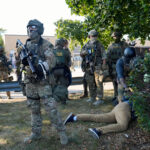(RNS) — The Church of England has named the Rt. Rev. Sarah Mullally archbishop of Canterbury, entering a new chapter in its history. Mullally’s appointment represents historic progress but also brings renewed tensions about women’s leadership. As many conservative bishops in the United Kingdom and across the Anglican Communion are voicing their disappointment, these tensions may soon be pushed to a breaking point.
To illustrate how overdue this development is, consider that all “seven sisters” of mainline American Protestantism — the established denominations that include Lutherans, Episcopalians, Methodists, Presbyterians, American Baptists, Disciples of Christ and the United Church of Christ — have already had female leaders or, when the position exists, denominational heads.
But these first female leaders came at a cost. While no U.S. denomination has split solely over the question of women’s ordination or their consecration as bishops, women’s leadership has contributed to ruptures that were also caused by a combination of internal disagreements over the ordination of LGBTQ+ clergy and same-sex marriage as well as more theological concepts such as biblical inerrancy.
Three years after the Episcopal Church elected the Rt. Rev. Katharine Jefferts Schori, then-bishop of Nevada, its first female presiding bishop, a conservative group of parishes and dioceses broke away in protest, forming the Anglican Church in North America, known as ACNA. Women’s leadership also caused friction in Presbyterianism, leading to a split in its largest denomination. While the most visible issue in debates that preceded these fractures was the one of LGBTQ+ clergy inclusion and ordination, opposition to it tends to overlap with the rejection of women’s leadership.
In the Church of England, disagreements over women’s leadership have deep roots. After the ordination of its first group of female priests in 1994, protests from conservative quarters were so vocal that an informal accommodation called “Alternative Episcopal Oversight” had to be introduced. Until this day, those who do not wish to engage with a female bishop can form a relationship with a “flying bishop” — a male prelate who is aligned with their position — instead.
Such was the outcry that it was another 20 years before the Rev. Libby Lane was appointed bishop. While the Alternative Episcopal Oversight arrangements have made coexistence of various factions possible, it is unclear how they will continue to work after the appointment of the new archbishop.
Mullally’s opponents aren’t restricted to England, as the archbishop of Canterbury is the first among equals of the bishops of the worldwide Anglican Communion. The Global Fellowship of Confessing Anglicans, a network of conservative-leaning churches known as GAFCON, has already critiqued her affirmation of blessings for same-sex relationships, and its chair, Archbishop Laurent Mbanda of Rwanda, said the archbishop of Canterbury could no longer serve as a “focus of unity” within the Anglican Communion. The same issue drew criticism from conservative Church of England clergy in the U.K.
Survivors of sex abuse by Church of England clergy are also lamenting the appointment. One of them, identified as Gilo, described Mullally as a “continuity candidate after Archbishop Welby,” referring to Mullally’s predecessor, Justin Welby. He resigned in November 2024 after an independent report faulted him for not following up on sexual abuse accusations involving a longtime leader of Christian youth camps. The report, called the Elliot review, also pointed to a lack of transparency and accountability in the Church of England’s response to the scandal.
Mullally was involved in the work on that response. Gilo, who described Mullally’s interactions with him as “silencing” and “blanking,” added, “I don’t think she particularly represents a desire or willingness to bring about accountability.”
Overshadowed by controversy as Mullally’s appointment is, there are some bright spots, at least for female clergy and women considering ministry as a career. Her appointment is a landmark moment in a broader trend of women’s presence becoming gradually stronger in her denomination.
According to Church of England statistics, women made up 33.5% of stipendiary (salaried) clergy in 2022 — a 10-point increase since 2012. Reflecting an even faster pace of change, women’s ordinations increased from 36.6% in 2012 to 55% in 2020. Research indicates that girls who grew up interacting with clergywomen have higher levels of self-esteem than girls who did not. Further, women mentored by female clergy gain increased clarity about their sense of vocation.
This was certainly true for me. I was raised in the conservative Polish Catholic tradition, but I am now an ordained American Baptist minister. Before immigrating to the United States, I lived in the United Kingdom for more than a decade and even once met the then-Archbishop of York John Sentamu, at his residence, the Bishopthorpe Palace. But it was meeting a female Church of England priest for the first time that crystallized my own call to ministry as a possibility.
The church where this priest served had an open kitchen, a lounge, a restroom and a kids’ corner. Throughout my visit, people were happily dropping in to have a chat and a cup of tea. This experience was a shocking contrast with the cold and uninviting Polish Catholic churches of my childhood. I realized religion could be done differently.
And still, sex abuse scandals are dogging Protestant churches as well as the Catholic Church. It would be naive to think that anything but a profound change in the church culture is going to solve the issue, beyond a simple promotion of women leaders. But just as women’s ordination comes with costs, the progress it represents tends to presage a willingness to examine what kind of church its leaders are going to sustain.
(Anna Piela, an American Baptist Churches USA minister, is a visiting scholar of religious studies and gender at Northwestern University and the author of “Wearing the Niqab: Muslim Women in the UK and the US.” The views expressed in this commentary do not necessarily reflect those of Religion News Service.)



